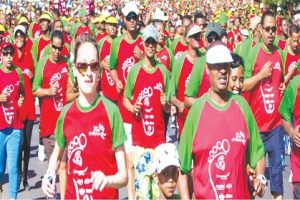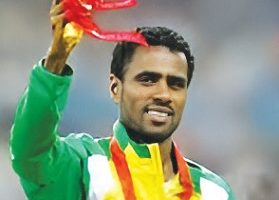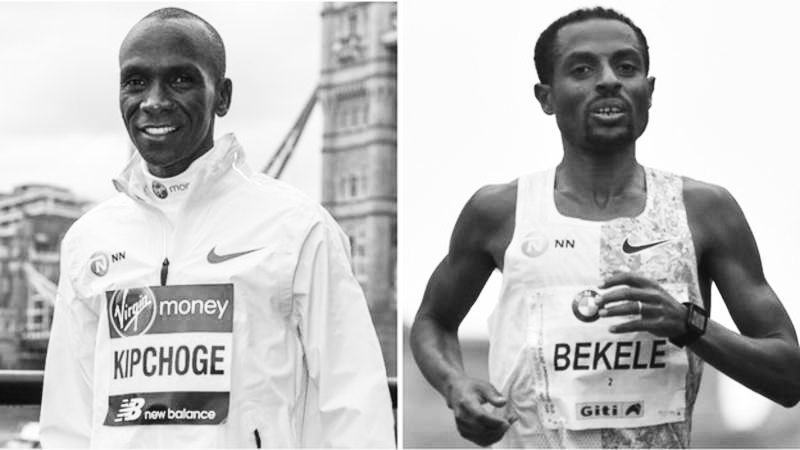
ADDS ABABA – The season’s Ethiopian Premier League came to a conclusion last week Sunday amid controversies on fixtures, crowed disturbance in its ugly ethnic basis and successive interruptions. In the premier league’s 22-year history clubs had never shown frustration like it was this season. The threat to boycott and a warning to withdraw was a common place.
Successive defeats on forfeiture were unseen similar to this one in the past. This was indeed a unique feature of the season. At the end a call for a new format became high on the agenda. Will the country’s football governing body, the Ethiopian Football Federation, EFF, bring in a new format or keep the existing one in line? It is now time to assess the situation before the new season begins in two months’ time.
The Existing Format
When the current format was introduced in the 1997/98 season the EFF President was Gizaw T/Mariam who was the manager of Muger Cement Factory at the time. But the most influential personality was his deputy Tsehaye Gebreigziabher.
The thinking at the time was that to give wider space for football participation. So that the structure was made on home and away basis with eight participating teams. One could say that giving chance to regional teams to participate in this top flight league was encouraging. Yes, it had a positive response on the side of football fans too.
But there was a fear that the structure would be a ground to accelerate ethnic feelings and eventually ethnic tension among the participants. The EFF was by then adamant and it didn’t have the ear to listen to what had been commented at the time.
The progress
At the start, the feelings of the people were sober and the focus was on football. Slowly and surely, the feeling of challenging the Addis Ababa teams grew day by day in a very clear manner. Oddly enough, this was done by the full knowledge and support of the football officials.
One example is enough to show the clear picture of this from the start: Without prior notification, that is without informing participants about the number of the Addis Ababa teams that will qualify for the Ethiopian Premier League first season, the EFF carried out qualifiers in Addis.
Then the federation decided to make the Addis representatives only three. This decision automatically hampered Saint George out of the first Ethiopian Premier League because St. George were by then stood fourth. This process lacks the football competition usual transparency.
In football, informing the purpose of the competition, the type of reward that will be given at the end, the number of participants, rule of promotion and demotion announced months before the competition begins.
In this sense, one can say, limiting the number of participating teams without notification was unfair. Laterally every one points his finger at the football officials. That was a sign of bias towards the Addis sides from the start. The first year ended marking this unfair scenario. The Addis side Electric lifted the first trophy 22 years ago and St. George joined the elite league next year.
Attacking the Addis side
The sentiment of attacking the Addis sides spread like the wildfire across the country. It has also grown as a political agenda claiming that the Addis clubs are beneficial all through while the regional teams are subject to subjugation.
Despite the growing bad sentiment against the Addis sides at initial stages the format served its ideal purpose very well. Many local players came to prominence and got high price in the transfer market. Even some of them got a place in bigger league in South Africa, Egypt and Yemen.
Imagine the national ace striker Saladin Seid who came from Assosa, a region little known in football, got a place in Egypt league. This was indeed a good achievement.
Another big win of the new format
The national team qualified for the African Nations Cup that was hosted in South Africa for the first time in 31 years. By then most of the young talents emerged from regional teams. Take for instance, defenders Degu Debebe, defender Abebaw Butako, quick and agile minded midfielder Shimels Bekele, strikers Saladin Seid, Adane Girma, Getaneh kebede were the new football super powers produced by the new format.
Side by side, a sense of belongingness to their ethnic group mushroomed day after day. The fans were divided among their ethnic lines. The Sidamas fully support only Sidama Coffee. What was seen further was that the Sidamas went far beyond the football limit: They began to oppose Hawassa City, a claim highly rooted in politics. The fans of Wolayita Dicha brought almost similar character. The Addis residents of the Wolayita origin began ardent supporters to their ethnic side; Wolayita Dicha.
Slowly this trend developed to the extent that losing to the visiting side in regional venues literally became impossible. Referees openly and in a meeting began to complain that they support the home team only for their safety because the fans associated defeat with the defeat of their ethnicity and became violent at the end.
When the country’s political scenario was changed in the wake of the Oromia protest in November 2015, that same feeling spread in football arena. When the protest spread to Gondar next year, the Amhara region, football became the center of expressing ethnic sentiments.
The role of EFF and regional football offices
The act of the EFF officials and the regional football federations added fuel to this tension. One good example of this was the fight between Mekelle and Woldiya City fans that happened three years ago. The fight erupted at the start of the season.
The fans of Mekelle City traveled to Woldiya having written provocative placards. The federation at Tigray didn’t inform the Woldiya people to prepare for defensive act or didn’t try to intervene to stop the high tempered fans.
At the same time officials at Woldiya in a subtle way supported their fans to take on the coming force. As a result three people died and a number of others injured.
The EFF decision was rather divisive. They ordered both sides to play in neutral venue. The ethnic tension really reached its climax. The federation has been handcuffed by its own formation. EFF executive committee members were also divided along their ethnic lines. This is where we are today.
The final match that took place in Tigray was also a master piece to show the intensity of the ethnic dimension.
Fasil City had the final match against Shire sihul. A win would give them the trophy. As a result of the penalty given to Sihul Shire, Fasil City were forced to finish level at 1-1 and lost that precious chance. As if that was not enough, the Shire Sihul fans wanted to attack Fasil City players and fans. At the end they were luckily unhurt after they were escorted by the defence forces.
That same night people in Gondar reacted angrily and started attacking the Tigrean community in Gondar city. Look what that means!! For totally unrelated things the people in Gondar began to revenge whom they think their enemy.
May be the remedy
EFF is currently working to ban or change names that are associated with ethnicity, according to the official announcement. Mekelle City is not an ethnic name but they represent a certain segment. Jimma Abajifar have closer connection with the Oromos. Sidama Coffee is a neutral name when seen from a far. How do they identify to ban or to order to change names?
The federation is also working to limit the salary of the players. As it was seen the capacity of teams will surely limit the players pay. The government can also intervene in this financial sect as all teams belong to them. The executive committee members were elected not based on talent but it is ethnic representation. Look at the club formation.
It is rather artificial because it is based on cities. This is not helpful to develop or promote football. There is no standard stadium in all regions that protect the visitors’ fans. The local police usually cooperate with the local people but the duty of police is to protect people. There is no camera fixed in different venues. The hooligans remain unidentified.
So it is now time to assess the entire format, the manpower of the EFF, the selection method of the Executive Committee and review of the participating teams, and if possible to look at having new format. But, this has to carefully and categorically be studied by experts or with knowledgeable people in the field.
The Ethiopian Herald July 16/2019
BY SOLOMON BEKELE




